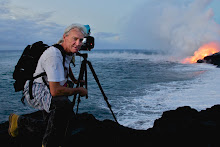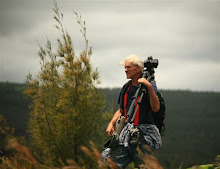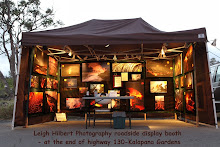 Above: the east end of the active lava delta just south of Kalapana Gardens, Island of Hawaii. Taken last week, this is the least active end of the bench; at least on this day. Notice the older sea walls running down the coast; everything below that is new land and still hot. To our right in this photo lava is pouring into the sea. Below shows the formation of that same section on August 7th, 2010
Above: the east end of the active lava delta just south of Kalapana Gardens, Island of Hawaii. Taken last week, this is the least active end of the bench; at least on this day. Notice the older sea walls running down the coast; everything below that is new land and still hot. To our right in this photo lava is pouring into the sea. Below shows the formation of that same section on August 7th, 2010 August 7th, 2010 -- Bench progress after two weeks.
August 7th, 2010 -- Bench progress after two weeks.
Around 2:00 PM on July 25th of this year a strong surface flow of lava breached the Hakuma horst and reached the sea. Molten lava pushed over the older sea wall cliffs and into the ocean; instantly beginning to form new land and black sand. Below: The Hakuma horst two days before lava breached it and found the ocean. (The images below are from the USGS Images page)

The new land being created is called a lava delta or lava bench and within two weeks there were nearly 20 acres of delta formed that jutted out into the ocean nearly 500-feet at its furthest point but also extended east and west producing 3000-feet of new coastline and a few continuously changing black sand beaches. Below: progress of delta formation on day nine to ten:

Eleven weeks later and lava continues adding more land along this new delta. But at the same time, due to the inherent instability of this kind of rapid lava-land creation, these deltas are highly prone to collapse. I have never seen one that did not collapse either partially or completely during the thirteen years I have been studying them along the south shores of the Big Island. (Continued below images...)
Below: Delta formation on August 6th:

Below: Delta formation on August 13th:

Below: Delta formation two weeks ago, September 30th:

When a lava delta breaks apart it can be piecemeal or in massive chunks. This can take place in minutes or slowly over many weeks or months. A break up of an active lava bench, one with lava moving through it, can be from mild local explosions as a smaller chunk of say 15 feet square falls into the sea, or incredibly violent with scalding tidal waves and massive littoral explosions of raw lava, ash, steam and propelled rock fragments {tephra}. Again, as posted before, check out this classic example of an entire lava delta collapsing. Notice the similarity to our current active delta.
Sometimes the delta sections do not simply break off but will fracture, allowing sea water to enter the cracks and contact the raw conduits supplying the raw and nearly 2000-degree lava within them. This can result in extremely explosive events; sending sheets of red-hot lava into the air. This can take place anywhere across an active delta that contains moving or stored molten lava. You can watch a USGS movie clip of that HERE
Sometimes there are warning signs ahead of either type of lava delta breakdowns: large or small cracks will form along the bench; these can be signs that the bench is fatiguing and about to break. These cracks can also form all the way inland within the old sea walls. On large bench collapses even the adjacent older cliffs can be fractured and fall into the sea. Ever-widening rock fractures there are often a forewarning. Also pre-collapses may begin with the delta shaking or making rumbling sounds.
…. And for an in-depth description about how lava deltas are formed and their inherent dangers, the USGS has an extensive page on that HERE
Meanwhile… coastal lava flow update:
From the Hawaii County viewing area road we can still see a robust ocean entry plume, which glows red-orange at night, as well as a few sporadic surface breakouts that are sometimes too far away to see well, but do occasionally break closer to the viewing area.
During the day the Pulama pali can be seen hosting long lines of degassing lava tube fumes.
Phone the Civil Defense lava hotline for current updates of openings or closures: 961-8093 (new updates sometimes are not announced until after 2:30 PM. After 2:00 PM you can phone the security staff at the viewing area at these two numbers: 430-1966 or 217-2215










Thank you for these blogs! I met you at the very end of the road 130 a few days ago, early in the morning while you were coming back from your morning trip to the lava flow. (I was the tall guy doing is morning run, with an orange T-shirt!)
ReplyDeleteYour job is awesome!
I'll continue to follow it even when back to my place!
Mahalo!
C